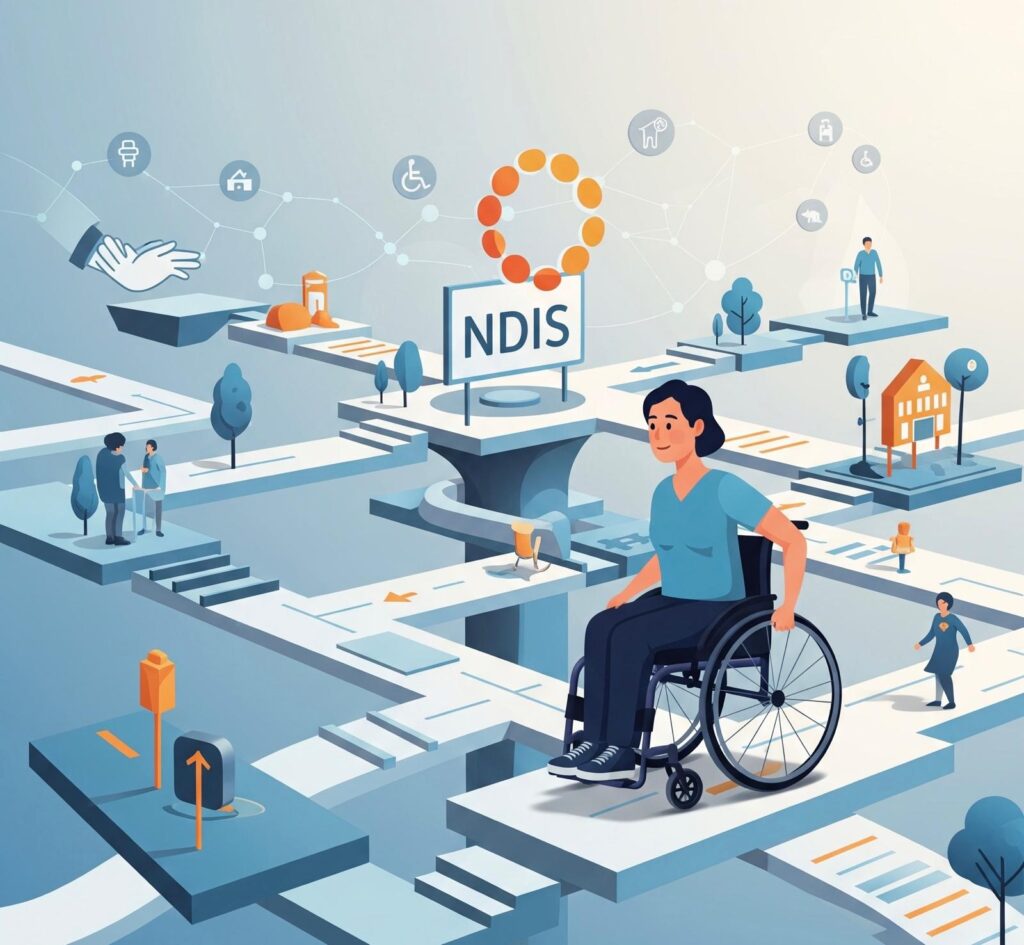2025 brings real change to the NDIS ecosystem. Your best “hacks” are:
- Write measurable goals and back them with functional evidence (e.g., Goal Attainment Scaling).
- Use the NDIS “Would we fund it?” and Reasonable & Necessary guidance as your decision filter.
- Pick the right funding management option (self/plan/agency) and know the pricing rules (including provider travel caps and per-km limits).
- Prep now for foundational supports (including the recently announced Thriving Kids program) so you’re not caught short when transitions begin (NDIA 2024; NDIA 2025; Department of Health, Disability & Ageing 2024–25; ABC News 2025).
Important: This is general information only—always check the latest NDIS legislation, rules and operational guidance before acting.
What’s Changed (and What It Means for You) in 2024–2025
New NDIS Act changes
The National Disability Insurance Scheme Amendment (Getting the NDIS Back on Track No. 1) Act 2024 received Royal Assent on 5 September 2024. Some changes took effect from 3 October 2024 and others are phasing in (NDIA 2024; legislation.gov.au).
Pricing & travel rules
The NDIS Pricing Arrangements & Price Limits (PAPL) 2024–25 v1.3 clarified many details:
- Travel time caps: typically up to 30 minutes each way.
- Non-labour travel costs: claimable separately (up to $0.99/km for provider/worker vehicles, plus tolls/parking where applicable). (NDIA 2024).
Self-management flexibility
Self-managed participants can use registered or unregistered providers and are not bound by NDIA price limits, provided purchases are still reasonable and necessary (NDIA 2024; NDIA 2025).
“Supports in / supports out” clarity
NDIA’s “Would we fund it?” library has been updated since the 2024 law changes to clarify many grey areas (NDIA 2025).
Foundational supports + “Thriving Kids”
On 20 August 2025, the Government announced Thriving Kids, a national foundational supports program for children with mild–moderate developmental delay or autism. Transitions are expected to begin mid-2026, with full rollout by mid-2027, ensuring no gap for families (NDIS Review 2023; Department of Health 2025; ABC/UNSW 2025; SPA 2025).
The 12 Smartest (and Ethical) NDIS Hacks for 2025
1) Write measurable goals and track them with functional evidence
Use validated tools like Goal Attainment Scaling (GAS). Providers can reference your GAS outcomes in reports at reassessment (Howlett & Gunes Sevinc 2024; Churilov et al. 2020; BMJ Open 2022; NDIA 2025).
2) Use Reasonable & Necessary + Would We Fund It as your purchase filter
Before spending, check eligibility, value for money, and whether the item is more appropriately funded elsewhere. Save screenshots for your records (NDIA 2025).
3) Pick the right plan-management mode
- Self-managed: maximum choice, not bound by NDIA price limits (but must comply with the Act).
- Plan-managed: invoices handled by plan manager; access to unregistered providers.
- Agency-managed: registered providers only; less flexibility.
Micro-hack: Ask providers to itemise invoices (face-to-face, travel time, non-labour travel). (NDIA 2024; NDIA 2025).
4) Know the pricing rules (so you don’t leak budget)
- Travel time: capped (typically 30 mins each way).
- Non-labour travel: claimable separately (up to $0.99/km, plus tolls/parking). (NDIA 2024).
5) Align your evidence with what the NDIS funds
Ask clinicians to reference Our Guidelines and “Would we fund it?” in their reports, and to show measurable functional outcomes. (NDIA 2025).
6) Use case coordination/support coordination strategically
Evidence shows robust coordination models improve outcomes (Suter et al. 2020; Jackson et al. 2018; Lukersmith 2020).
7) Prepare early for plan reassessments or unscheduled changes
Submit fresh reports, progress data, and a short cover letter linking goals to evidence. (NDIA 2025; DSS 2024).
8) For families of young children: map your pathway now
Keep strong functional evidence and monitor Thriving Kids rollout details (NDIA 2023–25; Department of Health 2025; ABC/UNSW 2025).
9) Avoid “supports out” traps
Check lists and “Would we fund it?” before purchasing to avoid repayments (NDIA 2025).
10) Use plan management reports to spot leaks
Review statements for travel overspend, unused budgets, or non-goal-linked expenses (NDIA 2024).
11) Be documentation-ready
Keep service agreements, invoices, notes, and screenshots of guidance (NDIA 2025).
12) Stay across policy signals
Government updates can affect pricing, eligibility, and supports (Department of Health 2024–25; NDIA 2025).
High-Value Scripts & Templates
Evidence request (GAS-framed):
“Could you please include baseline and follow-up scores and a brief Goal Attainment Scaling summary for each goal (−2 to +2), plus a sentence linking each recommendation to my NDIS goals and the Reasonable & Necessary criteria?”
Invoice wording (itemised travel):
“Please itemise: face-to-face time; travel time (minutes); and provider travel non-labour costs (km @ up to $0.99/km + tolls/parking, as permitted), consistent with PAPL 2024–25.”
Unscheduled change request:
“Since my last plan there has been a material change: [facts]. Attached: progress data (GAS), risk notes, and provider reports. I am seeking a [variation/reassessment] to align supports with safety and participation.”
FAQ
What does “foundational supports/Thriving Kids” mean?
Community-level supports outside the NDIS, starting with Thriving Kids (2025 announcement). Transitions begin mid-2026, full rollout by 2027 (NDIS Review 2023; Department of Health 2025; ABC/UNSW 2025; SPA 2025).
Can I use unregistered providers in 2025?
Yes, if you are self-managed or plan-managed. Agency-managed = registered providers only (NDIA 2024; NDIA 2025).
What’s a realistic way to cut travel costs?
Cluster appointments, use telehealth, choose closer providers, and pre-agree caps/rates in service agreements (NDIA 2024).
In-Text Citations Used Above
(NDIA 2024), (NDIA 2025), (Department of Health, Disability & Ageing 2024–25), (Howlett & Gunes Sevinc 2024), (Churilov et al. 2020), (BMJ Open 2022), (ABC News 2025), (UNSW 2025).
References
Australian Government / NDIA and related
- NDIA (2024) NDIS Pricing Arrangements and Price Limits 2024–25, Version 1.3 (1 Oct 2024). National Disability Insurance Agency.
- NDIA (2025) Would we fund it? National Disability Insurance Agency.
- NDIA (2025) Reasonable and necessary supports. National Disability Insurance Agency.
- NDIA (2025) Guide to self-management (updated). National Disability Insurance Agency.
- NDIA (2024) ‘New NDIS Bill receives Royal Assent’, NDIS News, 6 Sep.
- Department of Health, Disability & Ageing (2024–25) Budget 2024–25: Getting the NDIS back on track. Australian Government.
- DSS (2024) Variation and Reassessment Rules – Plain English Summary. Department of Social Services.
- Legislation.gov.au (2024) National Disability Insurance Scheme Amendment (Getting the NDIS Back on Track No. 1) Act 2024. C2024A00081.
- Legislation.gov.au (2024) NDIS (Getting the NDIS Back on Track No. 1) (NDIS Supports) Transitional Rules 2024. F2024L01257.
- NDIA (2023–25) Early Childhood approach – children younger than 9. National Disability Insurance Agency.
- NDIS Review (2023) Our Final Report: Guide for people with disability and their families. Independent Review of the NDIS.
Foundational supports / “Thriving Kids” (2025 announcements & analysis)
- Department of Health, Disability & Ageing (2025) Q&A from Minister Butler, National Press Club – 20 August 2025.
- ABC News (2025) ‘Minister expects states to match $2bn for Thriving Kids’.
- ABC News (2025) ‘Interview: Minister Butler announces $2b Thriving Kids program’.
- UNSW (2025) ‘“Thriving Kids” could help secure the future of the NDIS – what will it mean?’
- Speech Pathology Australia (2025) ‘Thriving Kids announcement: what we know so far’.
- ABC News (2025) ‘Foundational supports: future of disability services’.
Peer-reviewed & scientific / policy research
- Howlett, M. & Gunes Sevinc, G. (2024) ‘A systematic review of goal attainment scaling implementation practices’, Journal of Patient-Reported Outcomes, 8:37.
- Churilov, I. et al. (2020) ‘Goal Attainment Scaling outcomes in general inpatient rehabilitation’, Journal of Rehabilitation Medicine, 52:jrm00054.
- BMJ Open (2022) ‘Goal attainment scaling as an outcome measure in rehabilitation: systematic review’, BMJ Open, 12(7):e063061.
- Suter, P. et al. (2020) ‘Care coordination models and tools: a systematic review’, VA Evidence Synthesis Program.
- Jackson, C. et al. (2014/2013) ‘Impact of care coordination in Australia’s mental health services’, Australian Health Review.
- NDIA Data & Research (2022) ‘A narrative review of self-directed funding’. National Disability Insurance Agency.
- Productivity Commission (2011) Disability Care and Support (Vol. 1).
Bottom Line
The best “NDIS hacks” in 2025 are boring but powerful: set clear, measurable goals, collect functional evidence, shop smart within the pricing rules, and use official guidance before you spend. Keep an eye on foundational supports and Thriving Kids announcements, and build a paper trail so your next reassessment is a lay-up, not a lottery. (NDIA 2024–2025; Department of Health 2025).







